Sailing is fun, but sometimes it feels good to be back on dry land – and that’s where the best anchor rope comes in.
There are numerous models on the market you can choose from, but not all of them are suitable for your boat. Different breaking points, maximum loads, and materials – you have to consider a bunch of factors when looking for this rather essential piece of equipment. Down below, you can discover some of the finest yet most durable chains and ropes that will prevent your boat from wandering off, and learn how to pick an ideal model for your vessel.
See The Quick Comparison Chart
Advantages and Drawbacks of Using Anchor Ropes
1. Advantages
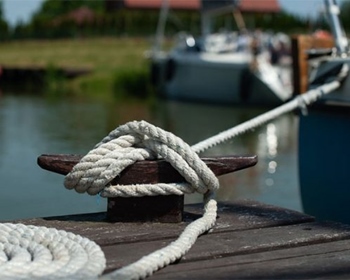 When being on the water (yes, even when anchored) a bunch of things can go wrong. However, when having the right type of equipment, you can prevent unwanted situations. Here’s why you should consider getting an anchor rope and/or a chain.
When being on the water (yes, even when anchored) a bunch of things can go wrong. However, when having the right type of equipment, you can prevent unwanted situations. Here’s why you should consider getting an anchor rope and/or a chain.
- An anchor rope and a chain can help you set the anchor faster.
- Some anchor ropes are elastic, especially those made of nylon, which makes the pulling an anchor down or up way easier.
- The chances of your anchor getting lose are significantly lower when using both rope and chain.
- Certain foreign objects can move or damage your anchor. A rope and a chain can reduce or prevent anchor damage.
2. Drawbacks
There are always two sides to every story. Although the benefits of using an anchor rope outweigh the drawbacks, it would be good to have these in mind, just in case.
- When not using a rope that is not suitable for the type and size of your boat and your anchor, you can find yourself in trouble. Always double-check the specifications of each product when choosing between units.
- Being caught in the middle of strong currents can make you lose your anchor if the rope/chain you are using is not strong enough.
- Low-quality ropes can withstand no more than 1 hour on the water. Staying any longer can cause the rope to break. That is why it is so important to choose a high-quality, durable product.
- Nylon ropes tend to absorb water and become a bit tricky to pull out of the water.
- Temperatures above 150°F can damage most synthetic anchor ropes.
- Using an anchor chain solely is not enough to absorb shocks so it would be best to combine an anchor rope and a chain.
Best Anchor Ropes Comparison Chart
| PRODUCT | DETAILS | ||
|---|---|---|---|
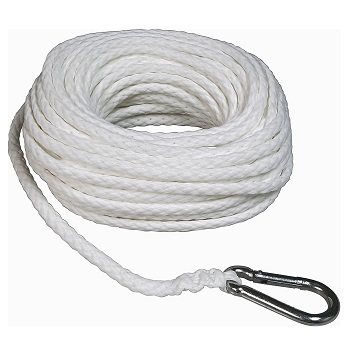 | SeaSense Hollow Braid Anchor Line Polypropylene |
| View On Amazon |
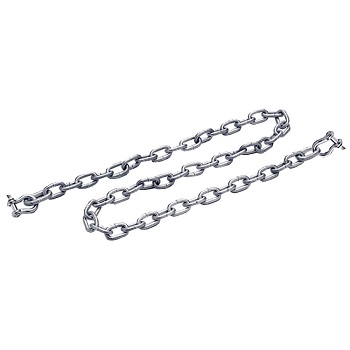 | SEACHOICE Galvanized Anchor Lead Chain |
| View On Amazon |
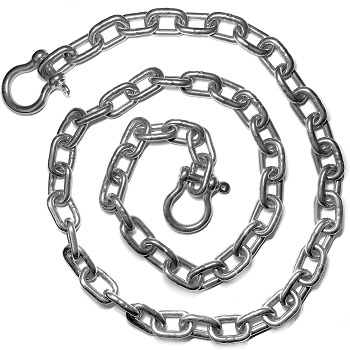 | US Stainless 5/16″ by 6′ Stainless Steel 316 Anchor Chain |
| View On Amazon |
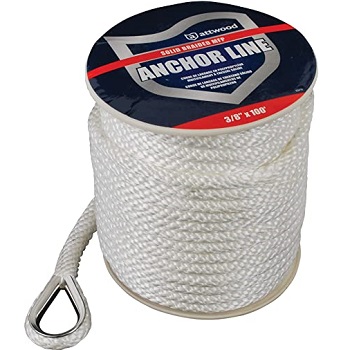 | Attwood Solid Braid MFP Anchor Line with Thimble |
| View On Amazon |
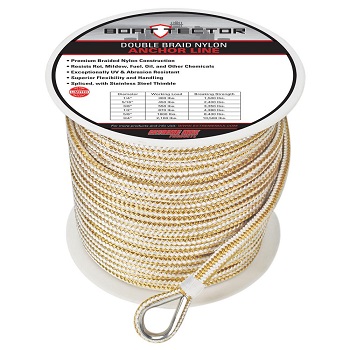 | Extreme Max BoatTector Double Braid Nylon Anchor Line |
| View On Amazon |
Best Anchor Rope Reviews
1. SeaSense Hollow Braid Anchor Line Polypropylene
 One of the lightest and most versatile anchors on the market, the SeaSense braid anchor might be a product worth your time. Designed to last for a lifetime, this 50-feet polypropylene rope that features a ¼ diameter is suitable for the use with vessels under 16 feet in safeguarded areas.
One of the lightest and most versatile anchors on the market, the SeaSense braid anchor might be a product worth your time. Designed to last for a lifetime, this 50-feet polypropylene rope that features a ¼ diameter is suitable for the use with vessels under 16 feet in safeguarded areas.
A plated steel spring hook and a sliced end make it effortless to connect it to the anchor. With an amazing break strength of 580 pounds and a recommended load of 63 pounds, you can rest assured this amazing endurance of the SeaSense anchor rope will keep you safe on the water.
Yet, keep in mind we would still recommend using this unit with light and smaller boats. Reliable and sturdy enough, the SeaSense rope is easy to use as well, especially when we talk about building an anchor rode.
Pros
- Hollow braid construction,
- Low-profile,
- Ideal for kayaks.
Cons
- Polypropylene tends to tangle,
- The rope gets heavier when submerged so it might be a bit difficult to pull it up.
2. SEACHOICE Galvanized Anchor Lead Chain
 If that floating anchor rope is getting on your nerves, the Seachoice chain can help you with this. This specifically designed chain is well-built and durable as it is made from galvanized lead. This material is corrosion and rust-resistant but also easy to handle.
If that floating anchor rope is getting on your nerves, the Seachoice chain can help you with this. This specifically designed chain is well-built and durable as it is made from galvanized lead. This material is corrosion and rust-resistant but also easy to handle.
With a breaking strength of amazing 7500 pounds and a workload limit of 1875 pounds, you can be confident it will work with almost any massive anchor. On the other hand, if you are living in an area where the waters can get tough, this working load limit will come handy one more time and prevent your boat from flipping over.
This anchor chain features rather standard sizes –5/16-inch in diameter and 5-feet in length, so you can rest assured it will fit most units you are planning to connect it to.
The Seachoice anchor rope is surprisingly lightweight for its capacities but we can consider this an advantage, as you won’t have a hard time pulling it out of the water.
Pros
- Abrasion-resistant.
- 4.4-pound,
- Performs great in mud.
Cons
- It’s not overly attractive.
3. US Stainless 5/16″ by 6′ Stainless Steel 316 Anchor Chain
 You can already guess by the name that this is one really massive anchor chair. US Stainless has a unit that will prevent your watercraft from rambling around. No wonder – it weighs over 5 pounds.
You can already guess by the name that this is one really massive anchor chair. US Stainless has a unit that will prevent your watercraft from rambling around. No wonder – it weighs over 5 pounds.
If you are at least somehow familiar with stainless steel, then you know type 316 is the best in class. This material is highly durable, resistant to corrosion and rust, and reliable. Cut explicitly for marine use, this could be a good choice for those who don’t want those one-size-fits-all products, but something that’s designed for boats only.
Two shackled (3/8 inches) on each end make attaching this chain to your anchor super-convenient. The main highlight of the US Stainless chain is that it features 7120 chain-breaking load, while the shackles can take up to 9460 pounds – amazing!
It’s not hard to see this anchor chain is a suitable option for any heavy anchor and large watercraft due to all listed properties that make it reliable and durable.
Pros
- Suitable for use in the harshest conditions,
- Suitable for all boat sizes,
- It has a nice finish that doesn’t fade with time.
Cons
- It is 6-feet long, while some of the customers wished it was longer,
- Slightly prone to scratching.
4. Attwood Solid Braid MFP Anchor Line with Thimble
 Multifunctional, reliable, and lightweight – these are the 3 best features of the Attwood anchor rope. A 100% multifilament polypropylene is resistant to saltwater, gas, oils, and UV rays, which means wear and tear won’t make it degrade a lot over time.
Multifunctional, reliable, and lightweight – these are the 3 best features of the Attwood anchor rope. A 100% multifilament polypropylene is resistant to saltwater, gas, oils, and UV rays, which means wear and tear won’t make it degrade a lot over time.
Another thing that makes this rope durable is the braid construction that is easy to handle. It won’t slip out of your hands when pulling it out of the water and you will be able to see it anytime as it is floatable.
Speaking of measures, it is 100-feet long and boasts a standard 3/8-inch diameter. The Attwood anchor rope can hold up to 250 pounds, so use it with smaller boats and lighter anchors to get its optimal performance.
A stainless steel thimble makes it easy to connect the anchor and the rope. The fact stainless steel is resistant to corrosion and rust when in saltwater comes as a bonus to the overall value the Attwood anchor rope provides.
Pros
- Floatable,
- Remains flexible even after years of use,
- Easy to pull up.
Cons
- Not suitable for use in rough waters and during strong currents.
5. Extreme Max BoatTector Double Braid Nylon Anchor Line
 Harsh marine conditions can make your boat swing and even pose a threat to your safety. Yet, with the Extreme Max boat anchor rope, you can be carefree about your boat even when the waters are nasty.
Harsh marine conditions can make your boat swing and even pose a threat to your safety. Yet, with the Extreme Max boat anchor rope, you can be carefree about your boat even when the waters are nasty.
This unit features a breaking strength of 4380 pounds and a load limit of 870 pounds, which could be a good solution for medium boats and medium to massive anchors, depending on the application.
Made of premium nylon, the Extreme Max anchor rope is durable and very resistant to acids, UV rays, salt water, mildew, and oils. It is also abrasion-resistant, as a double braid construction makes this rope less prone to wear and tear.
This obviously durable anchor rope can make attaching the anchor more convenient, and also prevent unraveling. It is available in a wide range of lengths and sizes so you won’t have a hard time finding the one that fits your vessel best.
Pros
- It doesn’t stretch,
- Stainless steel thimble on the one end,
- Shock load reduction.
Cons
- It is a bit flimsy so you should be careful when pulling it out of the water.
6. Extreme Max BoatTector Anchor Chain with 3/8″ Shackles
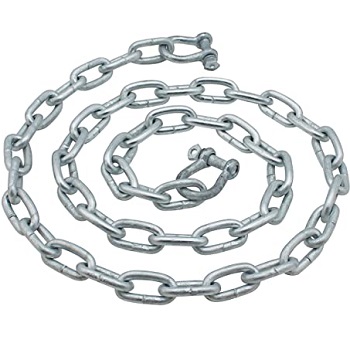 The Extreme Max anchor chain is one of the sturdiest units on the market. Made specifically from marine-grade stainless steel materials, it makes a great buy for those looking for a single-purpose chain.
The Extreme Max anchor chain is one of the sturdiest units on the market. Made specifically from marine-grade stainless steel materials, it makes a great buy for those looking for a single-purpose chain.
It comes with 3/8-inch shackles that are a bit oversized, but the main reason for such design is that these will hold onto massive boats and anchors easily. The chain itself is relatively lightweight – 1.5 pounds only, but it features 8000 pounds of the breaking length and the load limit of 2000 pounds.
You can use it even without an anchor rope, as it is 4-feet long and there is usually no need to let your boat wander any further. What is even better, shackles give you some extra room to customize the length to your preference, which is an added bonus.
Ideal for marine anchoring applications, the Extreme Max anchor chain
Pros
- Corrosion-resistant,
- Ideal for use in rough sea and strong current conditions.
- Links on both ends of the chain.
Cons
- Stainless steel scratches easily.
7. Rainier Supply Co Double Braided Nylon Anchor Rope
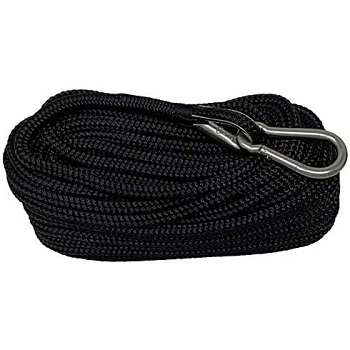 We have a double-braided anchor rope by Rainer Supply here that is very handy as it doesn’t slip from your hands like some of its counterparts. Made of durable nylon, this unit features a certain amount of flexibility as well. Nylon also provides a higher tensile strength, which makes this anchor rope a solid choice for medium boats and anchors.
We have a double-braided anchor rope by Rainer Supply here that is very handy as it doesn’t slip from your hands like some of its counterparts. Made of durable nylon, this unit features a certain amount of flexibility as well. Nylon also provides a higher tensile strength, which makes this anchor rope a solid choice for medium boats and anchors.
You can use it in saltwater, as it is resistant to environments and absorbs shocks effortlessly. This unit comes with a thimble and a 316-grade heavy-duty stainless steel snap hook that make it versatile – you can use this rope for marine applications or off the water.
As it is ¼-inch in diameter and 50-feet long, the Rainer Supply fits most standard size boats, but more on the lighter side. Its breaking strength is 1574 pounds and the maximum load is 314 pounds so make sure to stick to the recommendations if you want to ensure a long lifespan of your rope.
Pros
- Resistant to rot, mildew, and acids,
- Comfortable to handle,
- It can withstand heavy use.
Cons
- Not suitable for use with larger and massive anchors.
8. Norestar Double Braided Nylon Anchor Rope/Line with Thimble
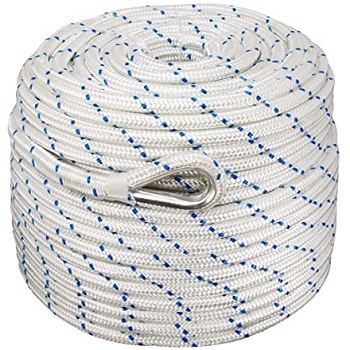 Norestar knows how important it is for you to ensure your safety on the water, which includes ensuring your vessel as well. Their anchor rope with the thimble is designed with durability in mind. Made of nylon, this unit features a great lifespan as it is resistant to chemicals found in the water, saltwater, as well as UV rays.
Norestar knows how important it is for you to ensure your safety on the water, which includes ensuring your vessel as well. Their anchor rope with the thimble is designed with durability in mind. Made of nylon, this unit features a great lifespan as it is resistant to chemicals found in the water, saltwater, as well as UV rays.
Besides being long-lasting and reliable, the Norestar anchor rope boasts a double-brain construction that prevents tangling and makes it easy to pull the anchor from the water. You will notice the fabric stretches a bit, but pulling won’t damage the fiber.
Attaching the thimble is simple and quick. You can choose between different lengths and sizes to find the unit that fits your boat best – whether it be a small or a large vessel.
Pros
- Suitable for nearly any boat,
- Ties easily but tightly,
- Multiple-use.
Cons
- The manufacturer claims it is 5/8-inch but the truth is it is a bit smaller.
9. Extreme Max Vinyl-Coated Anchor Chain 1/4″ x 4′ / Black
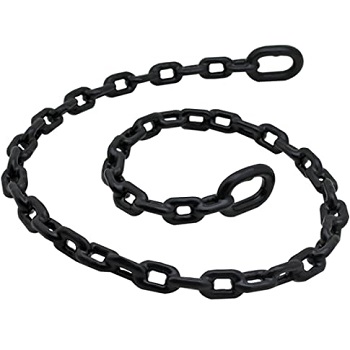 You don’t find vinyl-coated anchor chains every day, which is why the Extreme Max unit might be worth your time. This type of coating makes the chain very resistant to damage and prone to regular wear and tear, but, most importantly – it won’t damage your vessel. If you want to protect your boat from scratches, Extreme Max is a way to go.
You don’t find vinyl-coated anchor chains every day, which is why the Extreme Max unit might be worth your time. This type of coating makes the chain very resistant to damage and prone to regular wear and tear, but, most importantly – it won’t damage your vessel. If you want to protect your boat from scratches, Extreme Max is a way to go.
This anchor chain is resistant to rust as it is galvanized, which ensures its longer lifespan. Although its primary use is for marine anchoring applications, it might be useful in everyday off-the-water activities.
It is available at a standard size – 4-feet long and ¼-inch thick so you don’t have to worry about whether it will fit your anchor. Enlarged links on both ends make it easy to attach to the anchor.
The Extreme Max anchor chain features a breaking point of 5000 pounds and a load limit of 1250 pounds, which means it is suitable for use with most boat sizes.
Pros
- Can withstand strong currents,
- Easy retrieval,
- Lifetime warranty.
Cons
- It doesn’t come with shackles.
Types of Anchor Ropes and Chains
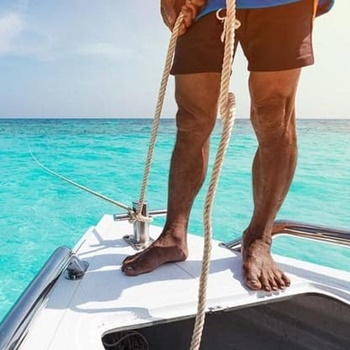 Once you drop your top-rated boat anchor into the water, you can’t be fully confident the currents won’t wear it away all until you attach an anchor rope or anchor chain (in the best case – both) to your anchor. These marine supplies come in different shapes and sizes, so let’s get familiar with the most common types of anchor ropes and chains.
Once you drop your top-rated boat anchor into the water, you can’t be fully confident the currents won’t wear it away all until you attach an anchor rope or anchor chain (in the best case – both) to your anchor. These marine supplies come in different shapes and sizes, so let’s get familiar with the most common types of anchor ropes and chains.
1. Anchor Ropes
1.1 Double-braid Line Rope
The most common type – double-braid rope features high shock load, but breaking point can be a bit of an issue. If you need a rope that will back your anchor up for a couple of hours, go for it. Yet, if you think it will require more time to spend on the hook, get familiar with the other two types of anchor chains.
1.2 3-Lay Nylon Rope
Nylon is one of the most durable materials in the marine equipment section. Reliable and strong, this anchor rope is also stretchy, so it can move a bit. Thus, you would have to check it every once in a while when on the water. If you are usually taking longer boat trips, this might be the one.
1.3 Megaplait Nylon Rope
An improved version of 3-lay nylon rope, this one is more resistant and can take more load. It makes an excellent choice for spending a few days on the water, but you would have to spend a little bit extra to get more benefits.
2. Anchor Chains
2.1 BBB Chain
The strongest of them all, BBB anchor chains are made of carbon steel. It is more expensive than the two other types, but it can take higher loads and features a higher breaking point. If you have a large boat, keep this one in mind.
2.2 High Tensile Chain
Carbon alloy is a material that boasts high tensile strength but not as good as it is the case with BBB chains. Yet, it is more lightweight too, which makes it a better choice for medium vessels.
2.3 Proof Coil Chain
Made of galvanized carbon steel, the proof coil anchor chain is slightly less durable than the two previous types. Thus, it is more affordable and makes a solid choice for smaller or lightweight boats.
Anchor Rope Buying Guide
1. Material
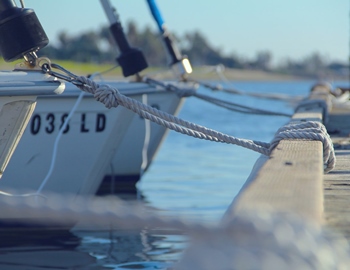 You can find anchor ropes made of nylon, polypropylene, and other synthetic materials. The choice of material is very important, as it will affect the durability of your rope. It would be best to find one that is somewhat flexible, features solid shock absorption capacity, lightweight, and the one that can stand heavy use.
You can find anchor ropes made of nylon, polypropylene, and other synthetic materials. The choice of material is very important, as it will affect the durability of your rope. It would be best to find one that is somewhat flexible, features solid shock absorption capacity, lightweight, and the one that can stand heavy use.
On the other hand, anchor chains are made of galvanized carbon steel, galvanized lead, stainless steel. Some of them are coated in vinyl, as this type of coating prevents damages to your vessel. Stainless steel chains are the most quality ones, yet some people find them too expensive. If you can’t afford a stainless steel unit, you can opt for an anchor rope with stainless steel shackles or links.
2. Type
We’ve already discussed types of anchor ropes and chains. Braided and laid ropes are more common than megaplait nylon ropes. Both of these provide excellent performance but keep these distinctions in mind.
If you don’t want to spend a lot of time interweaving, a laid rope might be a better choice. This one is more stretchy but tends to tangle. Braided ropes are flexible but less stretchy and trickier to interweave. Yet, braided ropes are stronger and can take more working load.
3. Breaking Point and Max Safe Working Load
Two of the most important numbers to pay attention to when choosing between units are breaking point and max safe working load, both displayed in pounds. Here, you should have the size of your vessel in mind.
However, you should be careful about these boundaries. Although a max safe load or breaking points can be high, make sure not to get too close to these ultimate limits, otherwise, you would find yourself in an unpleasant situation.
If you have a large boat and a massive anchor, make sure to get a unit that can take high loads. On the other side, if your vessel is rather small, a lightweight rope would be the best pick, as a heavy chain might start dragging the vessel down. All in one – breaking point and max safe working load are matters of your safety when on the water.
4. The Size of Your Vessel
You want to find an anchor/rope that is suitable for the size of your vessel. The larger your boat is, the more stress the vessel will put onto either of these pieces. Give your boat some space, but don’t exaggerate. If you have a 9-feet vessel, go for an 8-inch rope.
Maintenance and Safety Tips
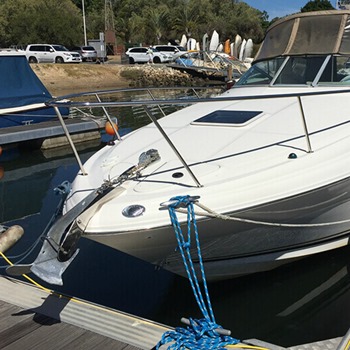 To ensure your safety on the water but to also prevent losing your anchor, follow the listed tips:
To ensure your safety on the water but to also prevent losing your anchor, follow the listed tips:
- An anchor rope might be just enough for smaller vessels and if you are usually going for short trips. Yet, we would recommend using an anchor rope and a chain at the same time.
- If you have a large and heavy boat, it would be better to use one or two anchor chains than a rope for safety reasons.
- Double-check your anchor rope and chain beforehand going in the water. If you find any signs of rust or the links are damaged, don’t use the chain anymore, otherwise – you will lose your anchor. The same applies to the rope. If it seems unreliable, don’t hesitate – change it.
- Each time you use your anchor chain, clean it properly afterward and inspect any damages.
- Never use assertive detergent with galvanized zinc or any other type of galvanized chain, as the chemicals can cause damage.
- Pre-soak the rope in hot water mixed with mild detergent for at least an hour. Saltwater and algae can make the rope stiff so you should keep it in the water for as long as it takes for the rope to soften. You can use a soft brush to take the algae off.
- We wouldn’t recommend washing the rope in a washing machine as some of the pieces can fall off and the rope wouldn’t be safe for use anymore.
- A spare rope or a chain can be your lifesaver in case things go wrong when you are on the water (if your current chain breaks down or if the rope rips off).
FAQ About Anchor Ropes
1. How to Install an Anchor Rope?
Installing an anchor rope is a no-brainer, but we highly recommend you to pay attention to how do you install it, as strong currents and waggles can move the whole application.
Once you have the right unit – a rope or a chain, you should attach it to the anchor and then, to your boat. Yet, the most secure way to prevent currents from damaging the rode is to install both.
You will find either a shackle or a link to connect everything tightly. Re-secure the connection and throw the anchor into the water.
2. What Size Anchor Do I Need For My Boat?
Here, you should have the anchoring depth in mind in the first place. You will need 8-feet of an anchor rope per each foot of depth. That means, if you are going to move around 10-feet deep water, you will need an 80-feet rope.
Secondly, your vessel’s length determines the thickness of the rope. Let’s say your boat is 9-feet long. In this case, you will need a 1/8-inch thick rope. If your boat is 27-feet long, opt for a 3/8-inch rope.
Also, you need an adequate diameter of an anchor rope if you want your boat to remain in place. Use 4.8mm in diameter ropes with vessels that are below 9 feet, while 9.5mm diameter is suitable for boats that are below 19 feet.
Keep in mind you will need additional 3.2mm for every 9 feet of extra length, or 6.4mm for 18 feet, etc. When it comes to anchor chains, you can get one that is for up to 3.2mm smaller in diameter than an anchor rope.
For instance, if your boat is 19-feet long, you will need a 9.5mm in diameter anchor rope and a 6.3mm in the diameter anchor chain. Yet, always check the manufacturer’s recommendations and the unit specs beforehand making a final decision.
3. How Do I Know If a Rope Is Strong Enough to Anchor My Boat?
Pay attention to the breaking strength and maximum safe load of the unit you intend to get. Generally, it is recommendable to get a stronger rope or a chain, but one that is too heavy would pull your boat down. Don’t go into the extremes but rather opt for a slightly higher load.
4. Can I Use a Regular Rope Instead of an Anchor Rope?
This wouldn’t be a good idea, as regular ropes don’t feature the same breaking point and maximum safe load as dedicated marine ropes do. Other marine dedicated products include top-rated boat fenders, top-rated marine binoculars, top-rated boat trailer tires, etc.
Also, anchor ropes and chains boast higher amounts of resistance to saltwater, UV rays, mildew, algae, and other marine elements, including contaminants. Using a regular rope would pose a threat to your safety even if you would be sailing in freshwaters.
Wrap Up
We guess that you have a complete image of anchor ropes and chains now. Either of these two can come handy when performing anchoring application, but it would be best to have them boat near at hand. Finding a reliable product is tricky, as you should have numerous features in mind. Thus, we created our anchor rope reviews to help you in the process.
Even the best anchor rope requires taking care of it, but things get easier when you have the right type of unit near at hand. Whenever you are ready to go for a trip, just check whether all of your marine supplies are on the boat and you will ensure a trouble-free experience.
If you liked this guide, we prepared plenty of other marine equipment guides to help you enjoy your trips to the fullest. Until the next ready – stay safe!
See also: boat fender reviews